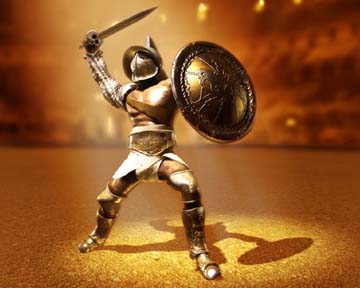|
"Gladiator" by Nathan Harris/Atomic Games,Copyright 2001. |
The Images of the Ancient World Database was created to provide a searchable resource for students and history educators seeking to illustrate their reports, presentations and research with appropriate images. History by its very nature is dependent on two factors that typical image databases ignore - time and place. This database includes fields for century, current or prior era, and geographic location as well as subject keywords and artist information. |
|
Database Structure: The database contains one record for each image. Due to the complexity of some images, separate detail images are also included and they, too, are each a separate record. If you have images you would like to include in the database, please send images with related information to mharrsch@oregon.uoregon.edu. Be sure total attachments do not exceed 1 Mb as the university mail gateway rejects messages with attachments over that size. Please include any copyright information. Copyright: For the purposes of this database, copyright status is based on U.S. copyright law because the database is hosted in the U.S. Copyright is considered "Expired" if the original work was produced before 1907. If the original work was produced between 1908 and 1950, the work may be copyrighted. Copyright permission for noncommerical, educational use has been obtained for the contemporary images included in the database.However, the copyright status field is for informational purposes only and should not be considered a legal reference. This database is intended for noncommercial, educational use by students and history educators. To use an image in the database, right-click on the image and select "Save Picture As", name the picture appropriately, and save it to your local drive. All images are in JPEG format (.jpg) that is compatible with either Windows or MacIntosh imaging software. |
|
| To search the database, click on the "Search" button in the toolbar along the top of the database. Click in the field you wish to search and input your search term. Then click the "Start Search" button on the left. You will see a list of records matching your criteria. To view the full record, click on the record listing or click "Form View" on the toolbar along the top of the database. To navigate through the records, click the "Next" button on the toolbar along the top of the database. To view all records again, click the "Show All" button on the left. | |
| The "century" field and "BCECE" field were added to facilitate searching a particular time frame. For example, the Mt. Vesuvius eruption that destroyed Pompeii occured in 79 C.E. - the 1(st) century. Remember when searching the century field that if you search for a period greater than (>) the numeric value in the century field and select B.C.E., you are looking for images older than the specified century. If you search for a period greater than (>) the numeric value in the century field and select C.E., you are looking for images more recent than the specified century. This database contains images of people and events up to 500 C.E. | |
|
Dates for general images of a particular culture were derived as follows: Egyptian images that are not specific to a particular century or dynasty are dated to the 13th century B.C.E., the age of Ramses The Great. Greek images of human subjects that are not specific to a particular century are dated to the 5th century B.C.E., the age of Pericles. If an image contains both mythological and human subjects, the image is dated to the period associated with the human subject. Images of the Trojan War are dated to the 12th century B.C.E. based on the generally accepted date of the end of the Trojan War of 1184 B.C.E. and the approximate dating of the 7th level of occupation of the archaeological site originally discovered by Heinrich Schliemann. Greek images of mythological subjects are dated to the 16th century B.C.E., the time some scholars have identified as the period when the rituals of the Eleusinian Mysteries began. Roman images that are not specific to a particular century are dated to the 1st century B.C.E., the end of the Roman Republic and beginning of the Imperial Period. Roman mythological subjects derived from Greek deities are dated the same as the corresponding Greek deity. |
|
